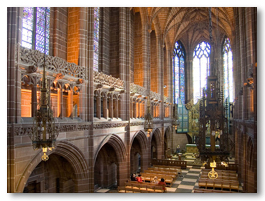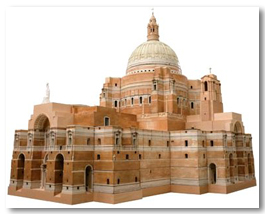What I would do if I were a multibillionaire
- PAUL JOHNSON
There is nothing sinful in amassing wealth, provided it is done justly.
 |
Liverpool Anglican Cathedral
|
Andrew Carnegie, in his essay ‘Wealth’, got it right. What is reprehensible is to hang on to it: ‘The man who dies thus rich, dies disgraced.’ By the time he went, in his sleep, in his 84th year, Carnegie had disposed of virtually everything, and he was buried at Sleepy Hollow, Tarrytown, New York, next to Washington Irving. A sizable volume, A Manual of the Public Benefactions of Andrew Carnegie (1919), shows that, by this date, $350,695,693.40 had been spent on a variety of gifts, including 2,811 free libraries and 7,689 church organs. The last item, considering he was an atheist, is interesting. Are you listening, Richard Dawkins?
If I were able to operate large-scale philanthropy, I would concentrate on one major project, to which I could make a personal contribution, as well as providing the cash. One scheme would be to create a college of all the arts with a particular mandate to produce Christian iconology of the highest quality. Modern church furnishings and decoration — and the churches themselves, for that matter — are deplorably dowdy, when not downright ugly. My college would seek to restore the creative glories of the Middle Ages.
The college itself would be a work of high art. There are precedents. For instance, there is Cranbrook Academy of Art, 20 miles from Detroit, founded in the 1920s by a newspaper publisher, George G. Booth. Its 300-acre campus is a paradise of pools, streams, fountains, gardens and woods, and the buildings, planned by the great Finnish architect, Eliel Saarinen, are of the highest quality, splendidly furnished in wood, glass, bronze, stone and marble. Cranbrook today has a threefold function. It is a training academy of skills for gifted students, a design laboratory for new ideas, and an artists’ colony where all live in delectable artistic harmony (don’t laugh). The college concentrates on nine disciplines: architecture, painting, sculpture, ceramics, design, work in fibre, metallurgy, photography and printmaking.
Of course Cranbrook is entirely secular. My arts college, which I would site just outside Oxford in the Cumnor Hills, would be Christian. Indeed I would like it to be a pilot project for a new Oxford college, teaching all subjects, including the sciences and medicine, but within a framework of Christian belief. By this I do not mean that the fellows and undergraduates would be aggressively church-going; merely that the sterile and destructive agnosticism so characteristic of Oxford life today would be conspicuously absent.
It would have a splendid chapel and a fine library, specialising in philosophy, theology, history and art. One feature of the college would be that all its resources would come from my foundation, so that it would not need to accept a penny from the state; and the foundation would likewise pay the fees and living expenses of the students without any call on local or central government. Thus the college would largely escape the monstrous bureaucratic interference which is now such a cruel and destructive feature of higher education in the UK. My model, again, would be American: Hillsdale College, Michigan, which has successfully set up such a state-free system and is able to teach in the pure spirit of the love of learning.
In addition to this new Oxford college, I would devote the rest of my colossal wealth — I am thinking in terms of billions — to redeeming the greatest architectural failure of the 20th century, one of the saddest stories in the entire history of art. Early in the century, the Anglicans of Liverpool began building the great new cathedral designed by Sir Giles Gilbert Scott, which is now complete and is the grandest modern building in England.
 |
model of Liverpool Metropolitan Cathedral
by Sir Edwin Lutyens |
When the Liverpool Catholics saw this noble structure begin to rise they were filled with a holy spirit of emulation, and in 1930 they commissioned Sir Edwin Lutyens — then head of the profession and the finest architect in the UK since Wren — to design something even more sublime. He did so, and produced a concept of breathtaking splendour. He had already given India the most exciting central government building of modern times, and at Thiepval in Flanders had erected out of the bloodstained mud the noblest of all war memorials. But Liverpool Metropolitan Cathedral was to be his masterpiece.
The concept, in so far as it had antecedents, was Byzantine rather than Latin. But essentially it sprang straight from the deep wells of his own imagination — it was sui generis. There was an underlying cruciform shape, with elements of nave, transept and chancel, but the essence of the design was the apotheosis of the curve and the arch. The whole was surmounted by a gigantic dome with a diameter of 168ft, compared to 137ft for St Peter’s in Rome and a mere 112ft for St Paul’s in London. Lutyens always had big ideas, but this cathedral was conceived on a scale that even he had never hitherto thought practicable. The length was 680ft, the width 400ft, the height to the top of the dome 510ft, and the surface area to be covered no less than 233,000 sq ft, making it the queen of all cathedral churches.
But sheer scale was not its virtue. Anyone who wants to grasp the elegance and majesty of the design should read the analysis of it by Sir John Summerson in his volume of collected essays. As he says, St Peter’s was designed from the inside out and St Paul’s from the outside in, but this work of Lutyens’s embodies the lessons of both, with interior and exterior beautifully and logically integrated.
Work on the project went on from 1933 to 1940, when it stopped forever. By that time a vast crypt had been built. It is a house of many labyrinthine marble mansions. It actually rises about 12ft above ground level, thus forming a stupendous plinth on which the cathedral itself, mainly of brick and stone, would have been built. Alas, only the model of it remains. In the 1950s, Cardinal Heenan, the archbishop of the city, despaired of raising the money to complete Lutyens’s great work. He held a competition for a new and cheaper design. The winning entry was circular, culminating in a glazed lantern with a spiked crown. This has some splendid deep-coloured glass, made by Patrick Reyntiens to a design of John Piper. But otherwise the design is without merit, concrete being much in evidence, and the lantern balanced by a huge entrance porch of unspeakable ugliness. The cathedral looks like a weird tent, and is known to the derisory Protestants of Liverpool as ‘Paddy’s wigwam’.
I would pull it down and build Lutyens’s cathedral exactly as he intended, regardless of expense. I have no doubt at all that the Liverpool Catholics would back the scheme. It would serve as a declaration of faith, not only for Liverpool but for all Britain, indeed all Europe — for the world in fact — in the power and majesty of the Christian religion, and the centrality of worship in the art, architecture and civilisation of the West. Money is nothing in itself, merely an abstract, a theoretical measure of value. The more it accumulates — the larger the number of noughts — the more unreal and even menacing it seems. But here would be something worthwhile to be doing with money on a vast scale, something which would last, and which would give countless souls yet unborn the fusion of great art and the shock of God’s love.
 This is Meaghen Gonzalez, Editor of CERC. I hope you appreciated this piece. We curate these articles especially for believers like you.
This is Meaghen Gonzalez, Editor of CERC. I hope you appreciated this piece. We curate these articles especially for believers like you.
Please show your appreciation by making a $3 donation. CERC is entirely reader supported.

Acknowledgement
Paul Johnson.
"What I would do if I were a multibillionaire." The Spectator (January 21, 2006).
This article is from Paul Johnson's "And another thing" column for The Spectator and is reprinted with permission of the author.
The Author






